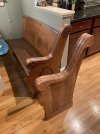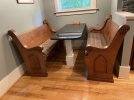I have seen several posts about renewing/resizing old church pews so I thought I'd ask for some help. My kitchen seating is an old pew that was cut to match the kitchen banquette. It was here when I bought the house and LOML and I both love the look. The problem is that when it was installed, it was cut too short and has about an 8 inch gap between the end and the wall so things keep getting dropped in the gap. My guess is that the carpenter who installed it cut it to length to match the table and then discovered that you couldn't get in or out because of the arms so they just moved it out enough to allow passage. So I decided to build a matching end and arm to finish the bench.
Here is the problem....
I have created a pattern to match the shape and am in the process of cutting, routing, and gluing 4, 3/4 think pieces of quartersawn oak to make matching arms. But the arm has a rather complex groove pattern in the top. After going through all my router bits and looking at the inventory at every online store, I have been able to closely match the groove pattern (see photo of SWP test piece) but have to use a sanding block pattern to create the final rounded center. Hand sanding that much oak is something I am willing to do (and forgo the gym that day) but I'd rather not. So I am asking this esteemed group of experts for any ideas.



Here is the problem....
I have created a pattern to match the shape and am in the process of cutting, routing, and gluing 4, 3/4 think pieces of quartersawn oak to make matching arms. But the arm has a rather complex groove pattern in the top. After going through all my router bits and looking at the inventory at every online store, I have been able to closely match the groove pattern (see photo of SWP test piece) but have to use a sanding block pattern to create the final rounded center. Hand sanding that much oak is something I am willing to do (and forgo the gym that day) but I'd rather not. So I am asking this esteemed group of experts for any ideas.



